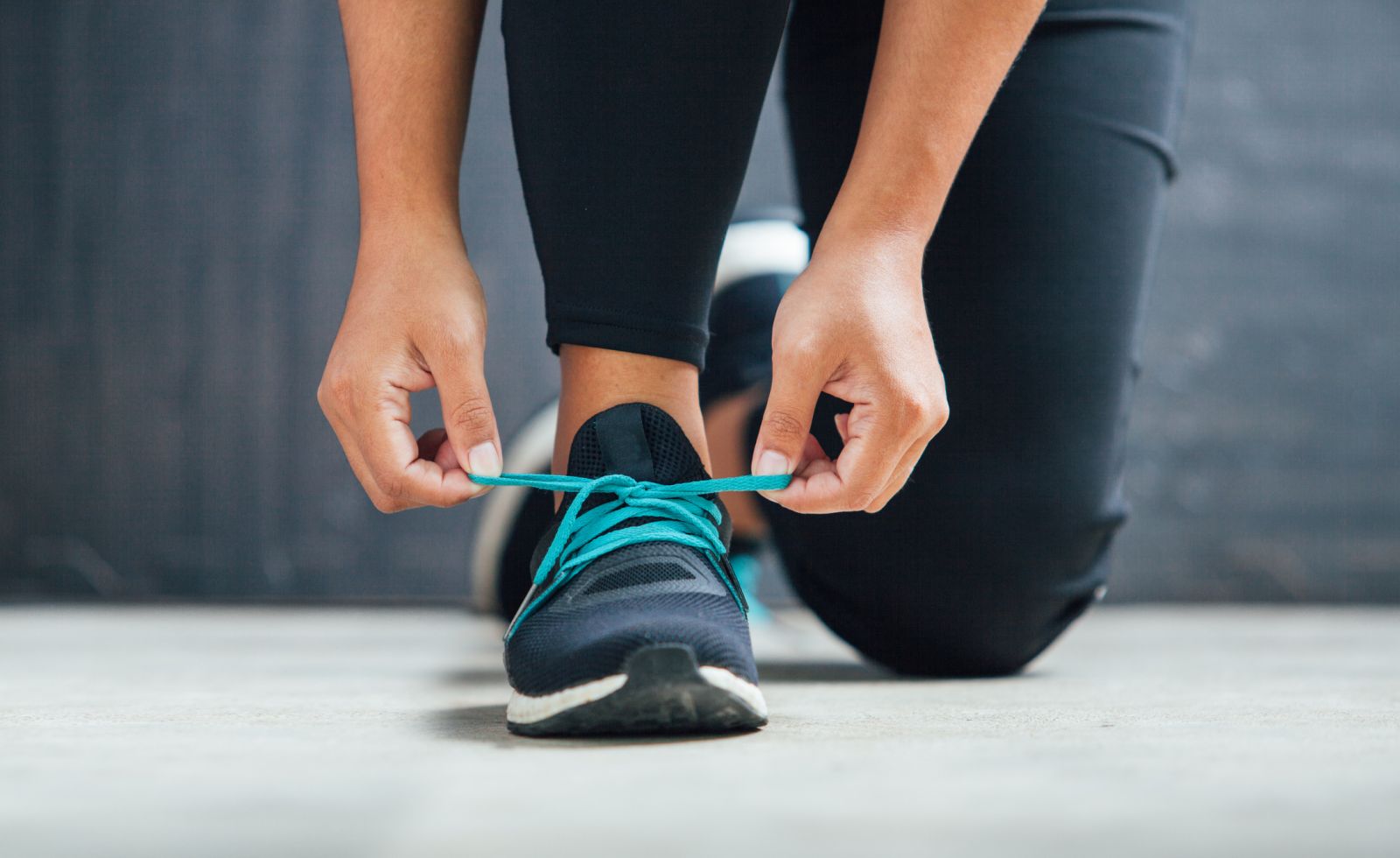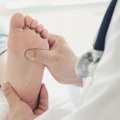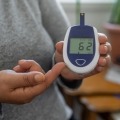Taking Care of Your Feet: How to Exercise Safely With Peripheral Artery Disease
By John Carr
 Lifestyle changes like diet and exercise are key to the prevention and management of diabetes-related complications like foot disease. Here’s why it’s important to be proactive about footcare, plus tips for exercising safely with peripheral artery disease.
Lifestyle changes like diet and exercise are key to the prevention and management of diabetes-related complications like foot disease. Here’s why it’s important to be proactive about footcare, plus tips for exercising safely with peripheral artery disease.
It’s become increasingly clear that diabetes exerts much of its devastation on blood vessels, both large and small. The damage in larger arteries is often a dramatic process with severe health complications like heart attack, stroke, and kidney failure.
Years in advance of these major catastrophic events, there is a silent, smoldering inflammatory storm in the walls of the tiniest blood vessels where nutrient and waste exchange takes place. This damage is at its worst in small blood vessels farthest away from the heart and lungs: the feet.
The benefits of physical activity are wide-ranging and well-established. And nowhere is this more true than in people with diabetes. However, when problems with the feet develop, it can discourage and prevent exercise. Here are some strategies for exercising safely and protecting your feet, especially if you have neuropathy or peripheral artery disease from diabetes.
How does diabetes injure the foot?
In people with diabetes, foot problems arise from elevated glucose levels. High circulating blood sugar levels compromise oxygen delivery, disturb nutrient exchange, and allow toxic waste products to collect, causing inflammation. While this can happen anywhere in the body, nerves in the feet are particularly susceptible.
As many as 50% of people with diabetes live with some form of diabetic neuropathy. Nerves can be damaged in two ways: from high blood sugar levels and poor blood circulation. Slowly the nerve degrades, muscle is lost, and eventually the structure of the foot is altered. This results in things like joint pain, poor function, and ulcers from small injuries that go unnoticed or become infected.
Foot problems from diabetes can overlap with diseases of larger blood vessels, such as peripheral artery disease (PAD). Signs of trouble in the feet can often be seen years before a major artery is clogged. Symptoms include:
-
Changes in skin texture and color
-
Nail fungus
-
Numbness or tingling
-
Loss of sensation
-
Painful burning toes
-
Loss of muscle mass
-
Decreased strength
What is peripheral artery disease?
PAD is a blockage to blood flow in large blood vessels and shares many risk factors with diabetes-related foot disease. These blockages can occur in people without diabetes too, often due to inherited cholesterol problems. Signs and symptoms of PAD include:
-
Cold feet
-
Loss of hair
-
Skin changes (thicker, less elasticity)
-
Red, shiny toes
-
Toenail discoloration and fungal infection
-
Calf pain or cramping while walking or climbing stairs
Together, foot disease and PAD are typical problems in people with diabetes. Around 50% of people with diabetes who develop foot ulcers also have PAD. In addition, living with PAD complicates the healing of ulcers and makes them more likely to occur.
Reducing disease progression through exercise
It can be hard to keep up with exercise if you have PAD or foot issues like ulcers, but board-certified foot and ankle surgeon Dr. Tom Biernacki reinforced the importance of physical activity. One study conducted over a 20-year period showed that those who lifted weights or participated in resistance training (like bands or squats without weights) had a 20% reduced mortality rate.
“If you also had some form of aerobic activity, like walking or jogging, you received an additional 20% reduction,” Biernacki explained. “Imagine that, 40% less likely to die, just by adding resistance training and aerobic training together.”
Recent research also demonstrates those who exercised demonstrated a greater degree of wound reduction. Importantly, there were no negative consequences to exercise for the participants.
Another study looked at people with freshly healed foot ulcers. One group performed foot-ankle flexibility and resistance exercises three times a week at home, and the other group received normal care. Only four participants who exercised required additional care, while 64% of people who did not exercise had ulcers come back.
Studies that demonstrate benefits to glucose control, A1C, quality of life, and other measures of fitness follow these two general principles:
-
Bodyweight, banded resistance, and free weights: Two to three sessions per week at moderate intensity, 8-10 repetitions for 2-3 sets.
-
Walking, jogging, cycling, or comparable: Three to five times per week at moderate intensity, 15-45 minutes (excluding warm-up and cool-down sessions).
Remember that any exercise is better than no exercise. Walking a minimum of 30 minutes three times a week has been shown to be effective in reducing the risk of major vascular events, but this is really a bare minimum. Professional organizations like the American Heart Association recommend a minimum of five days a week – if not every day.
If you don’t have access to a gym or a treadmill, there are plenty of home-based exercise programs. Some that include outdoor walking have even shown better results than treadmill exercise. It’s important to remember that exercise is dose-dependent, meaning that the more you get, the more benefits you’ll see.
Protecting your feet during exercise
Foot injuries and chronic conditions like PAD can be big barriers to exercise. The good news is, there are lots of steps people can take to protect their feet and safely get in the recommended amount of physical activity.
Avoid strenuous or high-impact exercises like running long distances, jumping rope, or lifting heavy weights. Aim to exercise in moderate weather or indoors during extreme weather (hot or cold). Try lower-impact exercises like walking, swimming, and cycling.
If you have an ulcer or open injury, let your feet rest for a day and stick to back and arm workouts like chair exercises. Avoid lifting heavy weights if you have an ulcer or open wound. For people with neuropathy and PAD, part of proactive foot care means checking your feet daily.
Make sure feet are clean and dry before exercising. Wear shoes that fit properly and offer support. Running stores often have great options and specialists to help you find the proper pair, even if you’re not a runner. Wear polyester or breathable socks that will keep your feet dry during physical activity. Drink lots of water before, during, and after activities to keep hydrated and keep your body temperature balanced.
Other ways to avoid foot problems
People with diabetes need to start early to guard against PAD or foot-related issues. That’s because once symptoms like burning toes, cramping calves, and loss of sensation appear, the disease is already present and it becomes harder to treat.
Along with exercise, here are steps you can take to prevent future problems or slow down disease progression.
Manage glucose levels
The underlying problem that drives damage in the lower extremities is elevated glucose. Excess blood sugar (hyperglycemia) overwhelms cells that line arteries, triggering a cascade of negative events. Similar to other major, devastating complications of diabetes like vision problems and kidney failure, better control of blood glucose and improving time in range is the starting point.
Biernacki emphasized early active involvement in foot care and has observed in his own practice real improvement in neuropathy symptoms by simply getting glucose levels under control.
“When people have very high blood sugar for a while and it drops with treatment, over about three months symptoms can improve significantly,” he said. “Part of this is reversible just by taking your medications properly and improving your diet, which includes getting the right nutrients, vitamins, and eating proven anti-inflammatory foods.”
Keep an eye on cholesterol
Another important aspect of preventing poor circulation (especially in larger blood vessels) is identifying and reducing any cholesterol abnormalities.
Cholesterol management often requires medication to achieve benefits. Luckily, many of these medications have been used for a long time and have a good track record with few side effects. Your doctor may use multiple medications to help you reduce the risk of catastrophic events like a heart attack or stroke. The specific medicine will depend on the person's unique profile.
Monitor blood pressure
Prolonged, elevated blood pressure makes blood vessels stiff and unresponsive. It also contributes to the inflammatory storm triggered by high blood sugar and cholesterol abnormalities, which directly damages arteries and nerves and can lead to diabetes-related foot disease.
Around 78% of people with type 2 diabetes have high blood pressure, which accelerates the progression of vascular diseases. Along with getting exercise and maintaining a diet rich in fruits and vegetables, treating high blood pressure may also require medication.
Stop smoking
Smoking, especially tobacco in cigarette form, is extremely bad for your arteries and accelerates nerve damage. Smoking is the number one cause of large artery disease, with 80% of people with PAD who are active or former smokers at an increased risk of all major catastrophic events.
Smoking also contributes to the development of diabetes, interferes with the effectiveness of insulin, and increases the risk of foot disease. In people who already have foot disease, smoking further increases the risk of amputation.
Quitting tobacco can be very difficult because of its addictive qualities. Few people are able to stop on their own and most require a supportive program that includes counseling and medication. The American Thoracic Society Clinical Practice Guideline strongly recommends using Chantix (varenicline) to stop smoking.
Eat a healthy diet
There are some easy and specific changes to your diet that can make a real difference. One simple change in your diet that can result in substantial health benefits is the addition of fish rich in omega-3 fatty acids.
“Oily fish consumption is very clearly associated with reduced risk of cardiovascular disease and mortality from cardiovascular disease. And this is particularly strong in those who've already had cardiovascular disease,” said Dr. Sara Berry, a cardiovascular nutrition specialist at King’s College of London.
By eating two or more portions of oily fish per week, you can reduce your risk by a whopping 80%. Examples include:
-
Salmon
-
Sardines
-
Atlantic mackerel
-
Cod
-
Herring
-
Lake trout
-
Canned, light tuna
Balance out your diet with foods rich in antioxidants and nutrients, including leafy green vegetables, whole fruit, nuts and seeds, and lean protein.
What if I’m already experiencing pain or numbness in my feet?
This is a real problem and one that too many people with diabetes struggle with.
"People are afraid to get their feet taken care of because they think it's gross. It's not gross. I'm telling you, we see this all the time and you could basically save your lifetime mobility,” said Biernacki.
“It's ridiculous how many patients come in and with a simple visit, they start walking and say this is the best I felt in 20 years. Seeing a podiatrist early can really help,” he said. “The great thing is that almost every insurance in America covers foot care because they recognize that going to see a podiatrist saves them billions of dollars.”
Diabetes-related foot disease and PAD are to be avoided at all costs; it’s a step into quicksand. The best way to keep yourself safe and healthy is to start from the ground up. By taking care of those feet, you are also taking care of your kidneys, eyes, brain, and heart.








